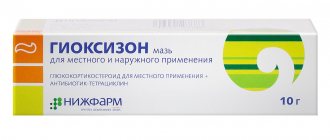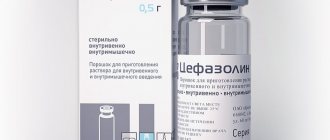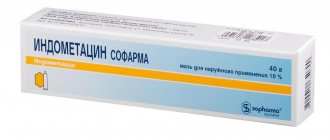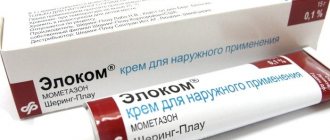The article was checked by a doctor Victoria Druzhikina Neurologist, Therapist
Sirdalud tablets belong to the group of muscle relaxants (drugs that reduce the tone of skeletal muscles with a change in motor activity up to complete immobilization).
Absorbed into the plasma, the active components of the drug have a blocking effect on the structures of the spinal cord and nerve impulse transmission. This relieves muscle hypertonicity and suppresses pain. The international nonproprietary name of the drug is “Tizanidine”.
Sirdalud tablets, instructions for use of which are listed below, are widely used in medical practice.
From this article you can learn the nuances of using the medicine, its price and compare it with analogues.
pharmachologic effect
"Sirdalud" is a centrally acting muscle relaxant, that is, its main effect extends to the skeletal muscles of the spinal cord. It has a stimulating effect on presynaptic alpha2 receptors, as a result of which the release of active amino acids that excite NMDA receptors is blocked. As a result of these modifications at the level of intermediate spinal neurons, inhibition of polysynaptic transmission of excitation is initiated.
This mechanism provokes an increase in muscle tone, so the use of Tizanidine will completely stabilize these processes and prevent their reoccurrence.
In addition, Tizanidine has a moderate antispasmodic effect. Therefore, the medication is used in the complex treatment of spastic pathologies of acute and chronic forms of spinal and cerebral etiology. It minimizes the risk of clonic convulsions and spasticity, effectively relaxes muscle muscles, which increases motor activity.
Pharmacodynamics and pharmacokinetics
Absorption of the drug into the blood occurs in the proximal region of the small intestine. This process occurs quite quickly, the maximum concentration of tizanidine in plasma is observed 1 hour after its consumption. When passing through the liver, the bioavailability of the drug decreases to 34% - this is due to its pronounced metabolic properties.
At rest, binding to blood proteins is 30%. The main binding substance is albumin. Bioavailability is not related to the gender of the patient, but may vary if there are differences in the daily dose of the drug (from 2 to 20 mg.). Also, the distribution and maximum concentration of the substance in plasma will depend on this indicator.
Primary metabolism occurs in liver cells. Tizanidine is metabolized by enzymes and the cytochrome P450 system. Such processes are carried out mainly with the participation of isoenzyme 1A2. As a result, the active substances of the drug are modified into a passive form.
"Sirdalud" is excreted exclusively through the kidneys. Moreover, 70% of the drug is inactive metabolites, and only 2.7% of the substance remains in its original form. The half-life of the drug from the bloodstream varies from 2 to 4 hours.
It should be noted that in patients with kidney dysfunction (kidney treatment is described here), the maximum content of tizanidine in the blood exceeds the norm by almost 2 times (while maintaining creatinine clearance less than 25 ml/min.). Consequently, the elimination period increases significantly, on average this figure is 14 hours. Therefore, patients with such deviations should take the drug only in a hospital setting, and the daily dosage and overall course of treatment should be calculated individually, taking into account all the listed circumstances.
Doctor's advice
Sirdalud works well, but periodically causes drowsiness and a drop in blood pressure. It is not always possible to prescribe it to older patients. If the patient spends time driving, the drug is contraindicated. In this regard, Mydocalm is safer.
Victoria Druzhikina Neurologist, Therapist
The pharmacodynamic and pharmacokinetic properties of Sirdalud do not depend on food intake.
The concentration may exceed normal values by 1/3, but this will not affect the therapeutic effect of the drug.
Medicine Sirdalud: conditions of sale, storage and special instructions
Stopping medication has its own nuances. Thus, the drug Sirdalud should be slowly reduced in dosage until use is completely discontinued. This can prevent or reduce the risk of high blood pressure and tachycardia.
This is most relevant in patients who use the drug for a long time and in large quantities.
Terms of sale
The medicine Sirdalud in tablets is sold in pharmacies only with a prescription from a specialist.
Storage conditions
Store Sirdalud in a cool place, out of reach of children, at a temperature not exceeding 25 degrees.
Best before date
The shelf life of the medicine can be found on the packaging; the drug is valid for no more than 3 years from the date of its manufacture. Special instructions. The drug contains lactose, therefore, Sirdalud cannot be prescribed to patients with severe malabsorption or congenital intolerance to the component.
In addition, if the patient has a history of liver disease, then before prescribing a medication, a doctor’s examination is required to identify possible risks of taking it. During the period of therapeutic measures using the medicine Sirdalud tablets, drowsiness and slight lethargy may occur, so control of transport, machinery and activities associated with an immediate reaction are impossible.
Indications for use of Sirdalud
Not many people know about Sirdalud tablets and what they help with. This remedy is characterized by a wide range of applications, so the medicine is prescribed for various pathological conditions in which it is necessary to produce a muscle relaxant effect on the nuclei of the spinal cord.
The main indications for prescribing the drug in accordance with the instructions are:
Neurological disorders:
- cerebral paralysis;
- multiple sclerosis;
- hemorrhages localized in the brain;
- myelopathy;
- degenerative-dystrophic modifications in the spinal cord;
- abnormalities of cerebral circulation.
- intervertebral hernia.
Muscle spasms caused by certain pathologies of the spinal column:
- osteochondrosis;
- syringomyelia;
- hemiplegia;
- spondylosis, etc.
- femoral osteoarthritis.
In addition to these diseases, Sirdalud is prescribed for the diagnosis of sclerotic type prostatitis. In this case, the use of the drug allows you to restore normal urination, improve erection and slow down the course of the pathology.
General information about the medicine
To determine why Sirdalud is prescribed, it is necessary to study in detail the description and instructions for use of the drug. All this information will help to accurately determine the patient’s need for medication and choose the most effective dosage.
Release form and composition
Pharmaceutical companies that produce Sirdalud (INN: tizanidine) offer patients only one dosage form - tablets. They have a flat, round shape and are painted white. Ten tablets are combined into strips sealed in cardboard boxes. One such package can contain up to three blisters.
The composition of this medication is also not very diverse. It includes one active ingredient and several auxiliary ones.
The correct combination of them allows you to obtain an effective medicine that will help in getting rid of some serious ailments.
One tablet of Sirdalud contains the following components:
- tizanidine (active ingredient) 2, 4 or 6 mg;
- lactose monohydrate;
- colloidal silicon dioxide (anhydrous);
- stearic acid;
- microcrystalline cellulose.
Indications
According to patient reviews, Sirdalud copes well with diseases of the spinal cord and spine. You can take it after consultation with your doctor. Only he will be able to accurately calculate the required amount of the drug and the duration of the course of treatment. If you do this work yourself, there may be a high probability of an error, which will lead to a deterioration in your health.
It is recommended to use Sirdalud to treat the following diseases:
- muscle spasms that appear as a result of diseases of the spine or after surgery;
- cervical and lumbar pain syndrome;
- spasticity (state of increased tone) of skeletal muscles;
- diseases of the muscular system associated with various neurological diseases (chronic myelopathy, multiple sclerosis; cerebral palsy);
- degenerative diseases of the spinal cord.
Main contraindications
Sirdalud, like any other medicine, has several contraindications
They should definitely be taken into account when purchasing and before use. If you neglect them, you can worsen the course of the existing disease and develop any side effects.
All this will greatly increase the recovery time, and will also make the whole process more expensive from a financial point of view.
It is prohibited to use Sirdalud tablets in the following cases:
- increased sensitivity of the body to the active substance of the drug;
- individual intolerance to one or more auxiliary components;
- severe liver diseases and disorders of its functionality;
- age under 18 and after 65 years;
- all trimesters of pregnancy;
- breastfeeding period.
In some extreme cases, the use of Sirdalud is allowed, even if the patient has one of the listed contraindications. This entire process must take place under strict dosage control and constant medical supervision.
Contraindications
Sirdalud helps to provide effective treatment for various serious conditions, but before prescribing it, the doctor must make sure there are no contraindications. These include:
- individual intolerance to constituent substances (including tizanidine);
- liver dysfunction;
- the use of drugs that have a strong inhibitory effect (for example, Ciprofloxacin, Fluvoxamine);
- lactase deficiency or hypersensitivity to lactose;
- age up to 18 years.
It is not recommended to take Sirdalud during pregnancy and lactation, since its effect on fetal development has not been established.
Patients over 65 years of age, as well as patients with severely impaired renal/liver function, should be treated with tizanidine with caution.
If these factors are present, the dose of the drug and the treatment period are determined individually and on the basis of a medical opinion.
Interaction
Concomitant use of the drug with inhibitors of cytochrome CYP1A2 leads to an increase in plasma levels of tizanidine, which in turn leads to overdose symptoms. Simultaneous consumption of Sirdalud with CYP1A2 inducers leads to a decrease in tizanidine levels, which causes a decrease in the medicinal properties of the drug.
The use of Sirdalud together with fluvoxamine and ciprofloxacin . The result of simultaneous use can be a significant decrease in blood pressure, which is accompanied by dizziness and drowsiness, and in some cases, loss of consciousness.
It is not recommended to take the medicine with antiarrhythmic drugs (such as Propafenone , mexiletine , amiodarone ), some fluoroquinolones ( norfloxacin , enoxacin , perfloxacin ), cimetidine , ticlopidine , oral contraceptives , rofecoxib .
Sirdalud should be taken with caution with drugs that prolong the QT interval ( amitriptyline , cisapride , azithromycin , etc.).
The use of Sirdalurd together with rifampicin reduces the content of tizanidine in plasma and, accordingly, reduces the therapeutic effect of the drug.
Treatment of men who smoke with the drug may require an increase in dose. Alcohol should be avoided, as the medicine may enhance the negative effects of alcohol on the central nervous system. The sedative effect of Sirdalud can be enhanced by sleeping pills, sedatives and antihistamines.
Side effects
On the 5th-6th day of taking Sirdalud, for pain associated with osteochondrosis, you can begin massage in the absence of contraindications (disc herniation). The first 2-3 days make it easy, then you can increase the strength of the impact. Without muscle relaxants, a course of massage can be started only after pain has been relieved, otherwise additional swelling will occur and recovery will be delayed.
Like any drug, Sirdalud can cause certain adverse reactions during therapy. Based on reviews, it can be argued that they mainly occur when using large doses of Tizanidine, but are not very pronounced, and therefore do not require its withdrawal. Rarely, patients experience such phenomena as:
- bradycardia;
- decrease in blood pressure;
- passing dry mouth;
- mild gastrointestinal disorders (find out how to get rid of diarrhea here);
- nausea;
- hepatitis;
- muscle weakness;
- apathy;
- drowsiness;
- dizziness (the causes of dizziness are written here);
- sleep disturbance;
- anaphylactic reactions;
- hives;
- decreased visual acuity;
- itchy sensation on the skin.
Side effects of Sirdalud
Patients may experience various side effects while using this medication, such as:
- The nervous system can often react with drowsiness, weakness, and dizziness. Rarely, hallucinations are possible along with insomnia and sleep disturbances.
- The cardiac and vascular system very often responds to this drug with bradycardia and decreased blood pressure. The side effects of Sirdalud can be very unpleasant.
- The digestive system responds with dry mouth, nausea, digestive disorders, increased liver transaminase activity and very rarely hepatitis.
- The skeletal and muscular systems rarely respond with muscle weakness.
- Other side effects of Sirdalud often include fatigue.
When taking the drug in question in small doses, which are recommended for relieving painful muscle spasms, drowsiness is noted along with fatigue, dizziness, dry mouth, a slight decrease in blood pressure, nausea, digestive disorders, and increased liver transaminase activity. The previously described side effects of Sirdalud, according to reviews, appear in moderate forms.
When taking this drug in a higher dosage recommended for the treatment of spasticity, absolutely all of the above side effects occur much more often and they are more pronounced, however, they are very rarely extremely severe so that treatment has to be interrupted. In addition, patients may experience symptoms such as low blood pressure, bradycardia, muscle weakness, insomnia, sleep disturbances, hallucinations, hepatitis, and so on.
Many people want to find an analogue of Sirdalud without side effects.
Instructions for use of Sirdalud
"Sirdalud" tablets, the instructions for use of which contain optimal information on the method of use of the drug, are prescribed individually. The correct dose and frequency of administration should be calculated by a specialist, based on the severity of the pathology and severity of symptoms.
Typically, the drug is prescribed in 1 tablet of 2 mg. three times a day. If necessary, a single dose is gradually increased to the required volume.
It is forbidden to start taking Tizanidine with a large dosage from the first day.
You can use the drug regardless of food intake, according to the following scheme:
- for muscle spasms – 2/4 mg. 3 rubles/day;
- spasticity caused by neuralgic abnormalities - start with 2 mg. up to 3 times a day, gradually increasing the daily dose to 12-24 mg, divided into 3 or 4 doses.
It is worth noting that patients with renal dysfunction should begin therapy with half the minimum dose, namely 1 mg. 1 rub./day Then the single dosage volume is gradually increased, and after a few days the frequency is duplicated. This mechanism is described in detail in the instructions for use of the product.
Sirdalud
Sirdalud (active ingredient - tizanidine) is a central muscle relaxant that acts directly on the spinal cord. The main point of application of his efforts are presynaptic alpha-2 receptors. By stimulating them, sirdalud prevents the release of amino acids that excite receptors for N-methyl-D-aspartate. As a result, at the level of interneurons (interneurons) of the spinal cord, polysynaptic transmission of nerve impulses is inhibited. Since this mechanism is responsible for excessive muscle tone, when it is suppressed, a decrease in muscle tone will be observed. In addition to the muscle relaxant effect, sirdalud also has a moderately pronounced central analgesic effect. The drug is effective both for acute spastic muscle pain and for chronic muscle spasm of spinal and cerebral origin. Sirdalud reduces spasticity and stops clonic convulsions, as a result of which the physiological barrier to passive movements is removed and the range of active movements increases. Therapeutic effectiveness and severity of unwanted side reactions depend on the content of the active substance in the blood. The drug is quickly and completely absorbed in the gastrointestinal tract. The maximum concentration of the active component in the blood plasma is achieved on average 1 hour after taking the drug. The bioavailability of sirdalud is relatively low - about 35%, which is due to the effect of the first passage through the liver. The pharmacokinetic characteristics of the drug when taken with food change slightly. The half-life of sirdalud averages 2-4 hours. Excretion of the drug from the body is carried out mainly by the kidneys.
Sirdalud is available in tablets. The drug has a narrow therapeutic range, which requires careful selection of the dose in order to protect the patient as much as possible. It was experimentally found that a starting dose of 2 mg 3 times a day can minimize the risk of side effects. In any case, the dose should be selected individually.
For spastic muscle pain, 2 or 4 mg are usually prescribed three times a day, with the possibility of taking an additional dose in especially severe cases (optimally before bedtime). For spasticity of striated muscles associated with neurological diseases, the starting dose of the drug should be no more than 6 mg per day. The dose should be increased gradually, at intervals of 3-7 days. In most cases, a pronounced therapeutic effect can be achieved at a dose of 12-24 mg per day. The maximum daily dose is 36 mg. There is little experience with the use of sirdalud in people over 65 years of age. In such patients, pharmacotherapy begins with the minimum effective doses, followed by a gradual increase in order to achieve an acceptable ratio of effectiveness and tolerability of therapy. When stopping taking the drug, to reduce the likelihood of developing withdrawal syndrome, manifested in this case by increased blood pressure and tachycardia, it is necessary to slowly reduce the dose until the drug is completely stopped. This is especially true for individuals who have taken sirdalud for an extended period of time. Arterial hypotension that develops while taking sirdalud may be the result of its interaction with antihypertensive drugs or CYP1A2 inhibitors. A number of sources provided information about liver dysfunction caused by tizanidine, but this did not apply to those cases where the drug was used in daily doses of less than 12 mg. In any case, it is recommended to monitor liver function indicators once a month, at least at the initial stage of treatment (and subsequently - only if appropriate clinical signs are present). A 30% decrease in the systemic bioavailability of sirdalud was found in men who smoke more than 10 cigarettes per day. During treatment, it is recommended to abstain from another human vice - drinking alcohol, because... otherwise, the risk of side effects increases.
Interaction with other drugs
According to the instructions for use, the drug "Sirdalud" is not recommended to be taken together with the following groups of medications:
- inhibitors of cytochrome P450 1A2 - “Fluvoxamine”, “Ciprofloxacin” (can provoke an overdose);
- CYP1A2 inhibitors - Mexiletine, Amiodarone, Pefloxacin, etc. (increases the risk of side effects);
- antihypertensive/diuretic drugs – can provoke a sharp decrease in blood pressure;
- antihistamines/sedatives – increase the risk of drowsiness.
Overdose
An overdose of Sirdalud Tinazidine can be expressed as follows:
- lowering blood pressure;
- vomiting , nausea ;
- drowsiness , dizziness , anxiety , miosis ;
- coma , respiratory failure .
Treatment: repeated intake of activated charcoal and forced diuresis will speed up the removal of the drug from the body. After removal, symptomatic treatment is carried out.
special instructions
Use of the drug in high doses (more than 12 mg) can lead to certain liver dysfunctions. Therefore, patients should undergo special tests regularly throughout therapy. Also, similar control is required for patients with anorexia, constant nausea and fatigue.
If an increase in AST and ALT levels in the blood is detected by three or more times, the course of treatment is canceled.
Experts advise refraining from driving if you experience undesirable effects such as dizziness, nausea, or low blood pressure.
Analogues of Sirdalud
There are a large number of analogues of Sirdalud on the pharmaceutical market, but you can replace the prescribed medicine only after agreement with your doctor.
| Analogue/tablets | Active substance | Average price/RUB |
| "Tizalud" | tizanidine | 230 — 400 |
| "Tizanidine-Ratiopharm" | tizanidine hydrochloride | 150 — 300 |
| "Mydocalm" | tolperisone | 450 — 700 |
| "Baclofen" | baclofen | 600 — 800 |
In addition to the listed analogues of Tizanidine, there are similar forms of the drug in the form of an injection solution (Miaxil, Midostat, Mydocalm, etc.).
The price of these drugs differs markedly from the cost of Sirdalud, but under certain circumstances their use is considered more appropriate. Consult a neurologist and find out about the possibility of replacing the drug with an analogue.
Analogues substitutes
On the pharmaceutical market, muscle relaxant drugs with the active ingredient tizanidine hydrochloride, in addition to Sirdalud, are presented:
Tizalud. Manufacturer: JSC Veropharm, Russia.
A muscle relaxant drug based on tizanidine hydrochloride in 2 mg tablets.
Tizalud is a centrally acting muscle relaxant, clinically and therapeutically effective, well tolerated by patients .
Its use is indicated for spastic conditions in skeletal muscles with pronounced pain syndrome in neurological diseases: degenerative changes, cerebrovascular accidents, multiple sclerosis, chronic myelopathies.
Tizalud is indicated for the treatment of pathologies of the spine and joints in the postoperative period (hernias, osteoarthritis).
Tizanidine
Tablets of 2 mg with the main active ingredient tizanidine hydrochloride.
Manufacturers: Berezovsky Pharmaceutical Enterprise (Russia), Teva Pharmaceutical Works Private Co (Hungary).
Instructions for use, indications and contraindications for the drug are the same as for Tizalud and Sirdalud.
The recommended initial dose of the drug is 2 mg.
Tizanil
Tablets 2,4,6 mg. Manufacturer Simpex Pharma Pvt. Ltd. (India).
Refers to central muscle relaxants, derivatives of tizanidine hydrochloride, an analogue of Sirdalud.
Relaxes the muscular system, indicated for chronic myelopathies, sclerotic changes, degenerative conditions of the spinal cord, strokes.
The muscle relaxant Tizanil is included in the complex therapy of osteochondrosis, intervertebral hernias, and post-traumatic cranial spasms.
Which muscle relaxant to use in the treatment of osteochondrosis is decided solely by a specialist .
Self-medication with muscle relaxants is strictly contraindicated and can cause irreparable harm to health!
Mydocalm or Sirdalud: which is better?
Patients often ask: “Sirdulad or Mydocalm, which is better?”
Medicines have noticeable differences in price, the last of them costs almost twice as much, but there is an almost complete absence of side effects when using it. “Tizanidine” and “Mydocalm” belong to the same group of muscle relaxants, but their composition is different, which means the mechanism of action will be different. The main active ingredient of Mydocalm is tolperisone. In addition, it contains lidocaine, so the instructions for its use indicate certain restrictions on the use of the drug.
Only the attending neurologist can prescribe medications.
Analogs
If we compare the descriptions of many painkillers, we can conclude that Sirdalud has no analogues. Their composition is identical and the therapeutic effect is the same. The list of analogues is as follows: 1. Baklosan 2. Tizalud 3. Muscle relaxant (any) 4. Baclofen 5. Movalis 6. Mydocalm 7. Tizanil 8. Tolperisone
If you do not know what to replace a certain drug with, refer to the Vidal reference book. Information about all medications is collected here.
What is better Sirdalud or Mydocalm?
In terms of efficiency, Sirdalud is better. In some cases, one capsule can work all day. But Mydocalm has to be taken more often. The indications of these drugs are similar, and the side effects of Mydocalm are more extensive, since it is older, but costs less. The group of muscle relaxants includes these two medications. For each patient, the medicine is selected individually depending on the diagnosis.
Price for Sirdalud
The price of "Sirdaluda" in different pharmacy departments may vary. Average prices are in the following range:
- tablets 2 mg – 200 – 400 rubles;
- tablets 4 mg. – 450 – 700 rub.
This article has been verified by a current qualified physician, Victoria Druzhikina, and can be considered a reliable source of information for site users.
Rate how helpful this article was
4.3 112 people voted, average rating 4.3
Did you like the article? Save it to your wall so you don’t lose it!











